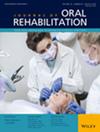Occlusal Contact Changes in Implant-Supported Fixed Prostheses: A Systematic Review
Abstract
Background
Implant-supported prostheses frequently face both mechanical and biological challenges. Although various techniques and principles are employed to manage excessive loads, occlusal contacts often change within 6 months of placement.
Objective
This review aims to analyse relevant studies to evaluate the changes in occlusal contacts that occur following the placement of superstructures in implant-supported prostheses.
Methods
The protocol was designed according to the Preferred Reporting Items for Systematic Reviews and Meta-Analyses Protocols (PRISMA-P) and registered with the International Prospective Register of Systematic Reviews. Studies were included if their outcomes addressed stress distribution, occlusal force, occlusal contact, occlusal scheme or changes in occlusal time. Non-English articles, case reports, animal experiments, systematic reviews and literature reviews were excluded.
Results
A total of 1867 articles were retrieved through database searches, along with an additional 43 articles identified through manual searches, of which 416 were duplicates. After screening the titles and abstracts, 1367 articles were excluded, and 12 were deemed non-retrievable. The full texts of the remaining 85 articles were independently reviewed by two authors for eligibility, resulting in the exclusion of 77 articles based on the inclusion criteria. Ultimately, eight articles were included in the review.
Conclusion
Implant-supported crowns gradually approach or surpass the load of natural teeth over time, as evidenced by increased occlusal force, larger contact areas and longer occlusion durations. These findings highlight the need for more accurate and advanced measurement techniques to better understand and manage the long-term changes in occlusion associated with implant-supported crowns.
Trial Registration
PROSPERO: CRD42024527043


 求助内容:
求助内容: 应助结果提醒方式:
应助结果提醒方式:


